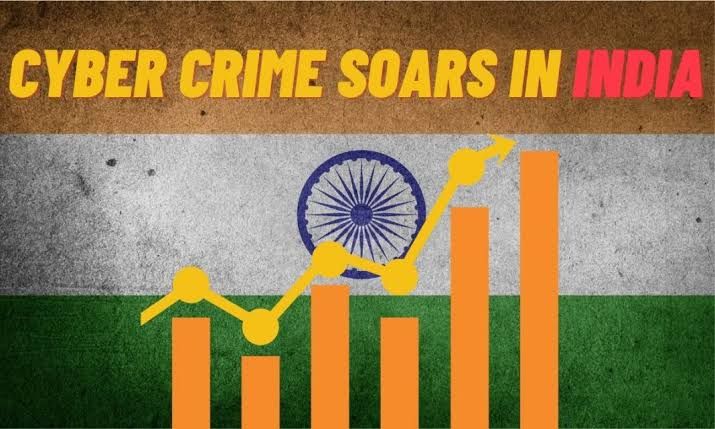Author: Devraj Sankla, Student at University College of Law, Osmania University.
Introduction:
Cybercrime is the illegal use of a computer, a computer network, or a networked device, as a tool to carry out criminal activities. It has become an increasingly major threat to individuals, computer systems, networks, data, businesses, and governments worldwide. In India, with the rapidly growing digital ecosystem, it also faces the global challenge of cybercrime. The country’s expanding internet connectivity and rising internet usage have made an attractive target for cybercriminals activities. Cybercrimes in India are diverse, from identity fraud and financial fraud to cyberbullying, data breaches and malware attacks. The impact of cybercrimes in India is significant as it has its impacts on the individuals and society at large. Individuals can suffer financial losses and emotional distress. Businesses may face reputational damage, financial losses, and operational disruptions. Governments can be compromised by cyberattacks, leading to national security risks. In India with low rate of digital literacy and less awareness about cybersecurity risks among the citizens which makes easy target of cybercriminals to exploit them.
Different types of Cybercrimes:
There are so many types of cybercrimes, some of them are mentioned below:
1. Online Job Scam: Online job scam is an attempt to scam people who are in need of job. In this the scammer takes money from the victim and gives them false promise that he will provide a good job with a good salary and runs away with money.
2. Credit or Debit Card Scam: In the Credit or Debit Card scam the scammer tries to use of victim’s credit or debit card information for purchasing something or to withdraw money from it without the card holder’s permission.
3. Online Drug Trafficking: The Online Drug Trafficking involves selling, transporting or illegally importing illegal drugs, such as LSD, cocaine, heroin, marijuana, or other illegal drugs using online.
4. Data Breach: A data breach occurs when a protected sensitive and confidential data is accessed and stolen by unauthorized person. It can involve personal data, financial records, or intellectual property. Such data breaches result in financial losses. To prevent such types of cyber attacks we need a strong cybersecurity law.
5. Child Pornography or Child Sexually Abusive Material (CSAM): Child sexually abusive material (CSAM) refers to the materials which contains sexual images in any form, of a child who is abused or sexually exploited. Section 67 (B) of the IT Act says that publishing or transmitting of material depicting children in the sexually explicit act, etc. in electronic form is a punishable offense. The Supreme Court of India recently ruled that viewing, storing, or distributing child pornography is a criminal offense under the Protection of Children from Sexual Offences (POCSO) Act. The ruling aims to enhance legal clarity and societal understanding of these heinous acts.
6. SIM Swap Fraud: SIM Swap Fraud is a type of fraud where a criminal convinces a mobile network operator fraudulently to transfer a victim’s phone number to a new SIM card. This allows fraudsters to intercept calls and messages and they get One Time Passwords (OTPs), required for making any financial transactions through banks and gain access to the victim’s bank accounts and other sensitive information. To protect against SIM swap fraud, it’s important to use strong authentication methods for online accounts, be wary of spam calls or messages asking for personal information, and report any suspicious activity to your mobile network provider and to cybercrime department.
7. Cyber Bullying: Cyber bullying is one of the forms of bullying or harassment in which bullying is caused through online digital platforms such as messages and social media. It involves sending, posting, or sharing negative or harmful content about someone through electronic or communication devices such as mobile phones, laptops and computers etc. The impact of cyberbullying can be severe, leading to anxiety, depression, and even suicidal thoughts in victims. Combating cyberbullying requires awareness, education, and strict enforcement of anti-bullying policies both online and offline.
8. Online Sextortion: Online Sextortion happens when someone threatens to upload private and sensitive material on public platforms using an electronic medium if he/ she doesn’t give money.
9. Spamming: Spamming is happened when someone send a spam commercial message via email, SMS, MMS and any other similar electronic messaging platforms to a large number of people. These are mostly promotional and advertising messages, but it can also be some type of phishing or scam attempts. The scammers may try to sell a product or service and ask the victim to visit their website and ask them to enter their personal details like bank account or credit or debit card details.
10. Cyber Stalking: Cyber stalking is the use of the internet or other digital platforms to harass or stalk an individual. This includes following someone online, sending unwanted messages to someone or hacking into personal accounts. Unlike offline stalking, cyber stalking can be more dangerous, as it allows the stalker to invade the victim’s privacy at any time he wants. The psychological impact on victims can be severe, leading to anxiety and fear. Legal measures and awareness are required to fight with this growing threat in our digital age.
Laws Related to Cybercrimes:
In India most of the cybercrime cases are governed by the Information Technology Act, 2000 (IT Act) and its amendments. This act provides an overall legal framework for regulating and addressing various cybercrimes.
The key provisions of the IT Act, 2000 related to cybercrime are:
Section 66: It deals with the offenses related to computer.
Section 66A: It deals with punishment for sending offensive messages through communication service, etc.
Section 66C: It deals with punishment for identity theft.
Section 66D: It deals with punishment for cheating by personation by using computer resource.
Section 66E: It deals with punishment for violation of privacy.
Section 66F It deals with punishment for cyber terrorism.
Section 67: It deals with punishment for publishing or transmitting obscene material in electronic form.
Section 67A: It deals with punishment for publishing or transmitting of material containing sexually explicit act, etc., in electronic form.
Section 67B: It deals with punishment for publishing or transmitting of material depicting children in sexually explicit act, etc., in electronic form.
In addition to the IT Act, other relevant laws in India include:
Indian Penal Code (1860): Contains provisions related to offenses like fraud, forgery, and extortion, which can be committed using computers.
Copyright Act (1957): Protects intellectual property rights, including online content.
Telegraph Act (1885): Regulates telecommunications and provides legal remedies for unauthorized access to communication systems.
These laws aim to provide a better legal framework to prevent, investigate and prosecute cybercrimes in India.
Steps to file a Cybercrime complaint online in India:
A cybercrime complaint can be filed online using the National Crime Reporting Portal of India.
Website link is – https://cybercrime.gov.in/
The Cyber Crime Helpline Number is 155260.
Step 1: Visit the National Cyber Crime Reporting Portal. Website link is – https://cybercrime.gov.in/
Step 2: Select the Type of Crime. Choose whether the crime is related to women/children or other cybercrimes
Step 3: Click on ‘File a Complaint’. This option will be available on the menu
Step 4: Carefully read the conditions and accept them
Step 5: Register Your Details. Provide your name, mobile number, and the details which are required.
Step 6: Fill in Incident Details. Provide all details about the incident, including date and time.
Step 7: If you have any information about the suspect, such as his name or contact details mention it in the complaint.
Step 8: Review all the information and submit your complaint
We can also track the status of our complaint through the website.
Conclusion:
In conclusion, cybercrime in India is an important and growing issue as the country continues to grow in the digital ecosystem. In India, there is very low digital literacy and less awareness about cybersecurity risks among the citizens. The government need to spread more awareness about the cybercrimes. The cyber criminals are very fast and they use different method to do cybercrimes. There are many legal provisions on cybercrimes, but the government need to bring more and strict legal provisions on cybercrimes, then only it can prevent cybercrimes. The process of filling a cybercrime complaint online is very convenient and quick process.
Frequently Asked Questions:
1. What is cybercrime?
A. Cybercrime is the illegal use of a computer to carry out criminal activities.
2. What are the different types of cybercrime?
A. There are so many types of cybercrimes, some of them are, Online Job Scam, Credit or Debit Card Scam, Data Breach and Cyber Bullying etc.
3. Which laws are related to cybercrime in India?
A. In India most of the cybercrime cases are governed by the Information Technology Act, 2000 (IT Act), Indian Penal Code (1860) and other relevant laws.
4. What is the Cyber Crime Helpline Number?
A. The Cyber Crime Helpline Number is 155260.





